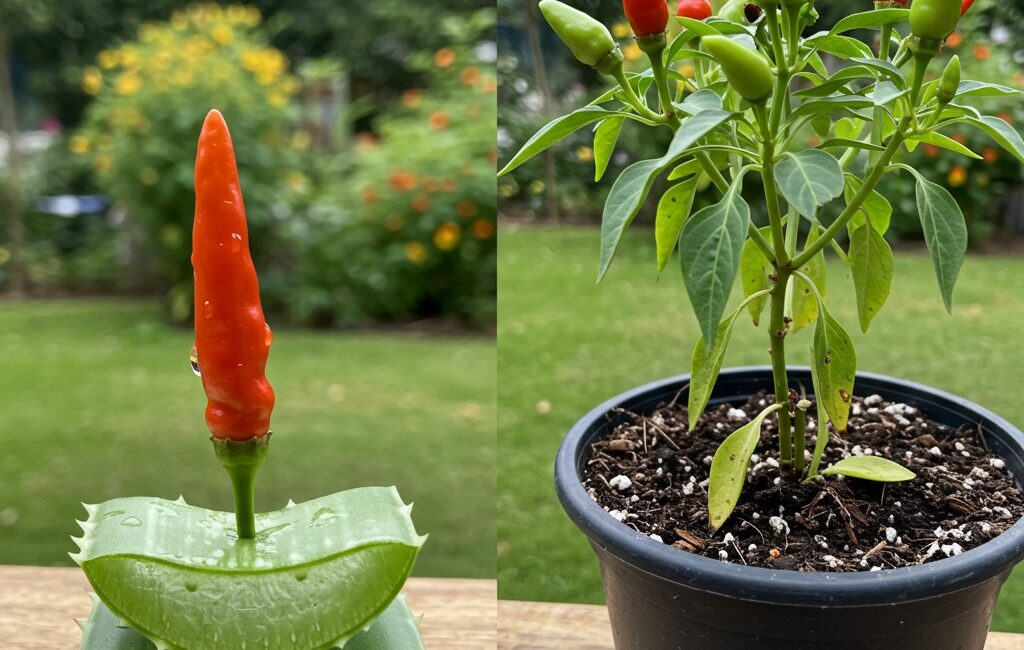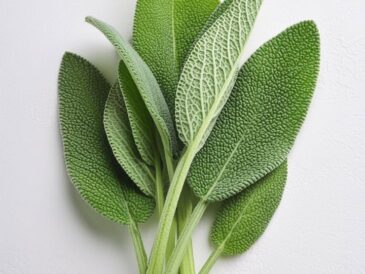- Dip the freshly cut end of the chili cutting into the aloe vera gel thoroughly, ensuring full coverage.
- For better rooting, you may dip twice, allowing the gel to dry briefly before the second dip.
Step 3: Prepare the Propagation Medium
- Fill pots or containers with a sterile, well-draining mixture of perlite, vermiculite, and peat moss or coco coir.
- Moisten the medium slightly but avoid waterlogging.
Step 4: Insert the Cuttings
- Make a hole in the propagation medium using a pencil or stick.
- Insert the cutting about 2 inches (5 cm) deep into the medium, ensuring at least one node is buried.
- Firm the medium gently around the stem to eliminate air pockets.
Step 5: Create a Humid Environment
- Spray the cuttings lightly with water.
- Cover the pots with a plastic bag or humidity dome to maintain moisture and humidity, crucial for root development.
- Ensure the plastic does not touch the leaves to prevent fungal diseases.
- Ventilate daily for a few minutes to prevent mold buildup.
Step 6: Position and Care
- Place the cuttings in bright, indirect sunlight—avoid direct sun which can cause dehydration.
- Maintain temperatures between 21°C and 27°C (70°F to 80°F).
- Mist cuttings daily to maintain humidity.
How Long Does It Take for Chili Cuttings to Root?
Rooting time varies depending on chili variety, environment, and cutting maturity, but typically:
- Initial root formation: 10–14 days
- Strong root system suitable for transplanting: 4–6 weeks
Gently tug the cutting after two weeks to check for resistance, indicating root development.
Transplanting Your Rooted Chili Cuttings
Once roots are established and 2-3 inches long, carefully transplant your chili cuttings into larger pots with high-quality potting soil.
Tips for Successful Transplanting
- Avoid damaging the roots.
- Water immediately after transplanting to settle the soil.
- Acclimate plants gradually to full sun over 1-2 weeks.
- Fertilize lightly with a balanced fertilizer after 2 weeks.
Common Challenges and Troubleshooting
Cutting Wilting or Drying Out
- Cause: Low humidity or overexposure to direct sunlight.
- Solution: Increase misting, use humidity domes, provide indirect light.
Rotting at the Base
- Cause: Overwatering or poor drainage.
- Solution: Use sterile medium, ensure good drainage, apply aloe vera gel for antifungal protection.
No Root Formation After 4 Weeks
- Cause: Cuttings may be too old or not receiving enough warmth.
- Solution: Use semi-hardwood cuttings, maintain consistent warmth (around 25°C), ensure adequate humidity.
Mold or Fungal Growth
- Cause: Poor ventilation and excess moisture.
- Solution: Ventilate regularly, reduce misting frequency, and use sterile tools.
Advanced Tips for Maximizing Success
Use of Supplemental Light
Providing supplemental grow lights with a full spectrum accelerates rooting and growth, especially in low-light environments or during winter.
Bottom Heat
Using a heating mat to keep the rooting medium between 25–28°C stimulates faster root growth.
Biochar and Mycorrhizal Fungi
Incorporate biochar into potting soil to improve moisture retention and microbial health. Mycorrhizal inoculants can further enhance nutrient uptake and root robustness.
Organic Nutrient Boost
After roots develop, feed young plants with diluted organic liquid fertilizers such as fish emulsion or seaweed extract to promote vigorous growth.
Benefits of Growing Chili Trees from Cuttings with Aloe Vera: A Summary
- Chemical-Free Rooting: No synthetic rooting powders required.
- Higher Success Rates: Aloe vera’s antimicrobial properties protect cuttings.
- Faster Plant Maturity: Skip the seed germination phase.
- Preserve Desired Traits: Clone your best chili plants.
- Sustainability: Reuse and recycle plant materials naturally.
- Cost Savings: Minimal investment for multiple plants.
Incorporating Chili Trees into Your Garden and Beyond
Culinary Uses
Home-grown chili peppers add fresh heat to sauces, salsas, and dishes worldwide. Growing your own ensures availability and variety.
Medicinal and Health Benefits
Chili peppers contain capsaicin, known for its anti-inflammatory, metabolism-boosting, and pain-relieving properties.
Market and Commercial Potential
High-quality, organically propagated chili plants have growing demand among gourmet chefs and specialty food producers.
Conclusion: Master the Art of Chili Tree Propagation with Aloe Vera
With this detailed guide, you are equipped to successfully propagate chili trees from cuttings using the power of aloe vera gel. This method is natural, cost-effective, and yields robust, fruit-bearing plants in less time than traditional seed methods.
Whether you are a home gardener or a commercial grower, mastering this propagation technique unlocks endless possibilities to expand your chili collection, maintain genetic purity, and enjoy spicy harvests year-round.
Start today—prepare your cuttings, harvest fresh aloe vera gel, and watch your chili trees thrive!




